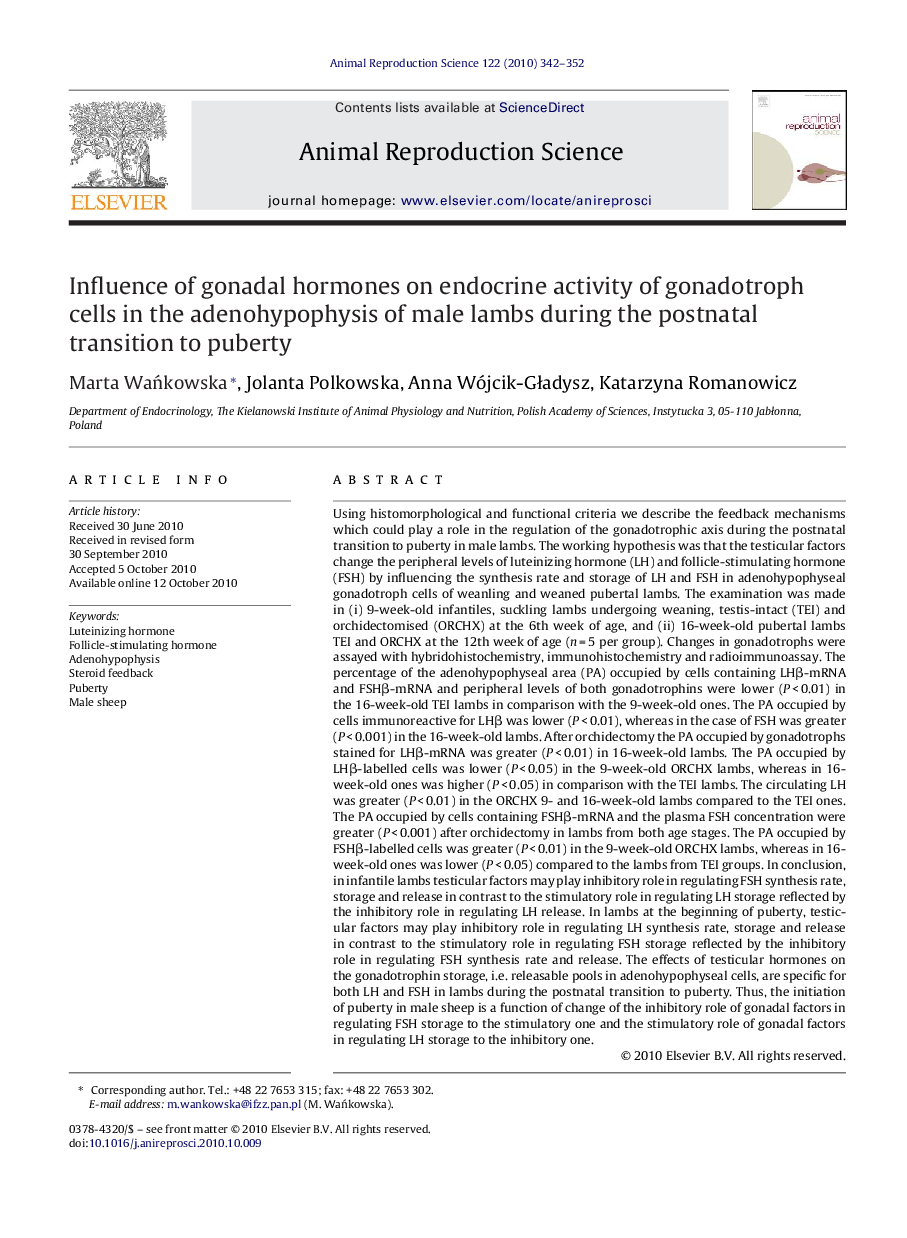| کد مقاله | کد نشریه | سال انتشار | مقاله انگلیسی | نسخه تمام متن |
|---|---|---|---|---|
| 2073659 | 1544778 | 2010 | 11 صفحه PDF | دانلود رایگان |

Using histomorphological and functional criteria we describe the feedback mechanisms which could play a role in the regulation of the gonadotrophic axis during the postnatal transition to puberty in male lambs. The working hypothesis was that the testicular factors change the peripheral levels of luteinizing hormone (LH) and follicle-stimulating hormone (FSH) by influencing the synthesis rate and storage of LH and FSH in adenohypophyseal gonadotroph cells of weanling and weaned pubertal lambs. The examination was made in (i) 9-week-old infantiles, suckling lambs undergoing weaning, testis-intact (TEI) and orchidectomised (ORCHX) at the 6th week of age, and (ii) 16-week-old pubertal lambs TEI and ORCHX at the 12th week of age (n = 5 per group). Changes in gonadotrophs were assayed with hybridohistochemistry, immunohistochemistry and radioimmunoassay. The percentage of the adenohypophyseal area (PA) occupied by cells containing LHβ-mRNA and FSHβ-mRNA and peripheral levels of both gonadotrophins were lower (P < 0.01) in the 16-week-old TEI lambs in comparison with the 9-week-old ones. The PA occupied by cells immunoreactive for LHβ was lower (P < 0.01), whereas in the case of FSH was greater (P < 0.001) in the 16-week-old lambs. After orchidectomy the PA occupied by gonadotrophs stained for LHβ-mRNA was greater (P < 0.01) in 16-week-old lambs. The PA occupied by LHβ-labelled cells was lower (P < 0.05) in the 9-week-old ORCHX lambs, whereas in 16-week-old ones was higher (P < 0.05) in comparison with the TEI lambs. The circulating LH was greater (P < 0.01) in the ORCHX 9- and 16-week-old lambs compared to the TEI ones. The PA occupied by cells containing FSHβ-mRNA and the plasma FSH concentration were greater (P < 0.001) after orchidectomy in lambs from both age stages. The PA occupied by FSHβ-labelled cells was greater (P < 0.01) in the 9-week-old ORCHX lambs, whereas in 16-week-old ones was lower (P < 0.05) compared to the lambs from TEI groups. In conclusion, in infantile lambs testicular factors may play inhibitory role in regulating FSH synthesis rate, storage and release in contrast to the stimulatory role in regulating LH storage reflected by the inhibitory role in regulating LH release. In lambs at the beginning of puberty, testicular factors may play inhibitory role in regulating LH synthesis rate, storage and release in contrast to the stimulatory role in regulating FSH storage reflected by the inhibitory role in regulating FSH synthesis rate and release. The effects of testicular hormones on the gonadotrophin storage, i.e. releasable pools in adenohypophyseal cells, are specific for both LH and FSH in lambs during the postnatal transition to puberty. Thus, the initiation of puberty in male sheep is a function of change of the inhibitory role of gonadal factors in regulating FSH storage to the stimulatory one and the stimulatory role of gonadal factors in regulating LH storage to the inhibitory one.
Journal: Animal Reproduction Science - Volume 122, Issues 3–4, December 2010, Pages 342–352